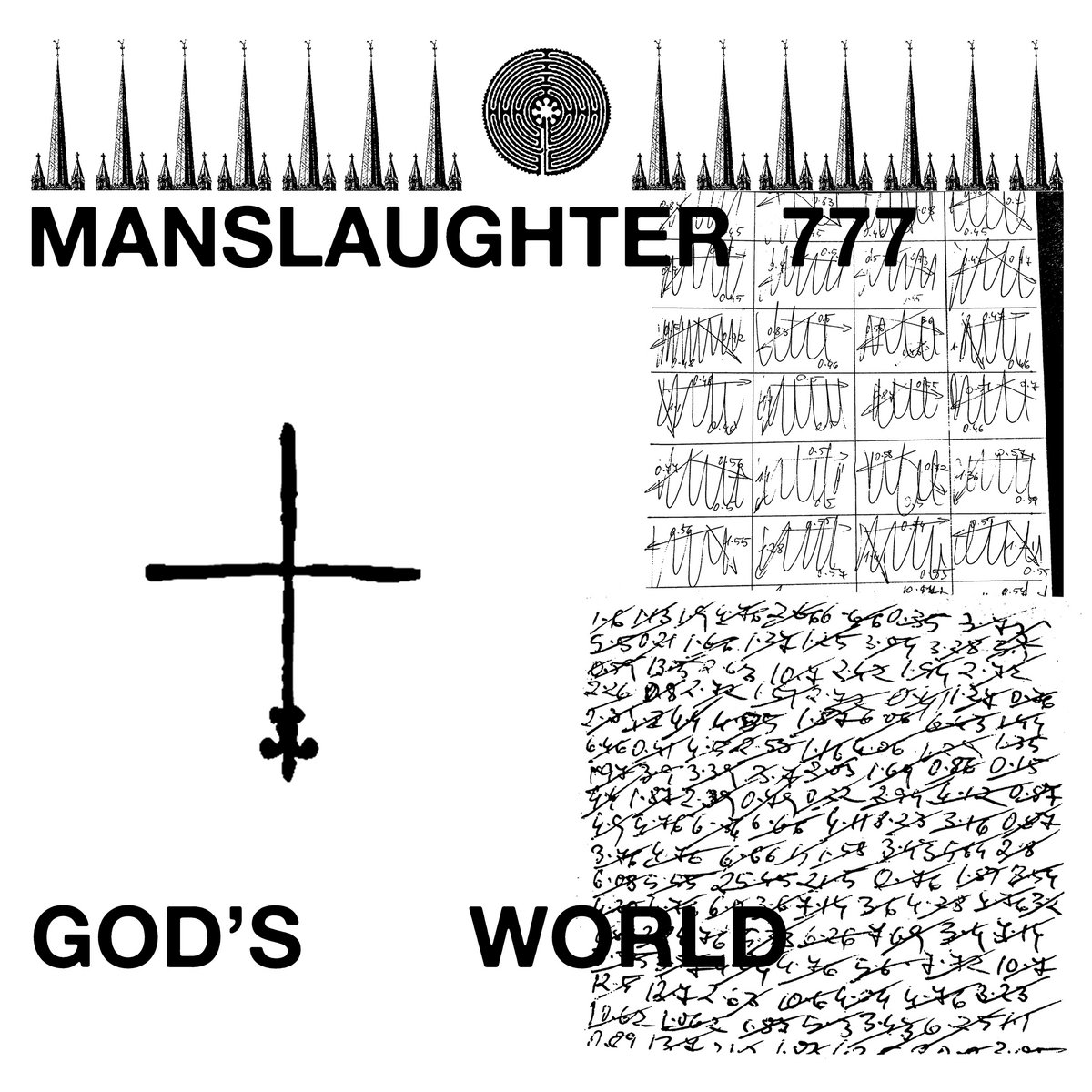Podcast Episode 767 is live

Racing towards the end of the year.
Still plenty of new music to enjoy from 2025 as well as some forthcoming music in 2026.
Episode 767 features new music by Marie Davidson, Paula Kelley, Tashi Dorji, FACS, K-LONE, A Place to Bury Strangers, Ginger Beef, Ruth Mascelli & Mary Hanson Scott, Brown Angel, Le Grand Couturier, Call Super, and The Stargazer Lilies, plus less than new music from Gnonnas Pedro & His Dadjes Band and Pete Namlook & Ludwig Rehberg (as The Putney).
Collage by Martin
Get involved: subscribe, review, rate, share with your friends, send images!















Read more …



 This latest EP from the ever-compelling Diamanda Galás has had quite an interesting journey, as it first began its life in an evolving larger work entitled "Das Fieberspital (The Fever Hospital)," which is a “musical setting of Georg Heym’s early 20th Century expressionist poem about patients stigmatized by yellow fever.” At some point, however, Galás concluded that “the piano skeleton had become its own work” and its (mostly improvised) performance was released as De-formation: Piano Variations back in 2020. Five years later, she was inspired to ambitiously rework that piece for a Paris performance at the Pinault Collection celebrating the legacy of fellow iconoclastic composer Maryanne Amacher. Now in deconstructed, reconstructed, and characteristically volcanic new form, De-formation: Second Piano Variations presents Galás’ “definitive” performance of that visceral tour de force.
This latest EP from the ever-compelling Diamanda Galás has had quite an interesting journey, as it first began its life in an evolving larger work entitled "Das Fieberspital (The Fever Hospital)," which is a “musical setting of Georg Heym’s early 20th Century expressionist poem about patients stigmatized by yellow fever.” At some point, however, Galás concluded that “the piano skeleton had become its own work” and its (mostly improvised) performance was released as De-formation: Piano Variations back in 2020. Five years later, she was inspired to ambitiously rework that piece for a Paris performance at the Pinault Collection celebrating the legacy of fellow iconoclastic composer Maryanne Amacher. Now in deconstructed, reconstructed, and characteristically volcanic new form, De-formation: Second Piano Variations presents Galás’ “definitive” performance of that visceral tour de force. To celebrate the remastered tenth anniversary reissue of his 2015 opus A Fragile Geography, Rafael Anton Irisarri invited an eclectic murderers’ row of his friends and peers to work their transformative magic on his source material. That was a bit of a bold and inspired decision given that the original album is quite bleak and grayscale in nature, but Irisarri’s well-chosen group of reinterpreters found a number of fresh and inventive ways to highlight their most inspired bits or sharpen them into something that beautifully transcends their original inspiration. To my ears, Abul Mogard and Kevin Martin largely steal the show with their killer contributions, but this whole album is a quite a fascinating companion piece to one of Irisarri’s most celebrated albums (and even manages to surpass it on several occasions).
To celebrate the remastered tenth anniversary reissue of his 2015 opus A Fragile Geography, Rafael Anton Irisarri invited an eclectic murderers’ row of his friends and peers to work their transformative magic on his source material. That was a bit of a bold and inspired decision given that the original album is quite bleak and grayscale in nature, but Irisarri’s well-chosen group of reinterpreters found a number of fresh and inventive ways to highlight their most inspired bits or sharpen them into something that beautifully transcends their original inspiration. To my ears, Abul Mogard and Kevin Martin largely steal the show with their killer contributions, but this whole album is a quite a fascinating companion piece to one of Irisarri’s most celebrated albums (and even manages to surpass it on several occasions). I was definitely not expecting a new Tear Garden album this year, but Edward Ka-Spel and cEvin Key’s fitful four-decade collaboration has happily resurfaced once again after an eight-year hiatus. I am tempted to call Astral Elevator a return to the duo’s “classic” sound after the more eclectic and playful The Brown Acid Caveat, but the only real difference is that this latest batch of tightly edited and hook-heavy “singles” has been purged of the more groovy and disco/dance elements found in its predecessor. I suppose that makes Astral Elevator a somewhat darker release, but the world is now a darker place then it was back in 2017 and there are a handful of highlights here that certainly brighten my small part of it.
I was definitely not expecting a new Tear Garden album this year, but Edward Ka-Spel and cEvin Key’s fitful four-decade collaboration has happily resurfaced once again after an eight-year hiatus. I am tempted to call Astral Elevator a return to the duo’s “classic” sound after the more eclectic and playful The Brown Acid Caveat, but the only real difference is that this latest batch of tightly edited and hook-heavy “singles” has been purged of the more groovy and disco/dance elements found in its predecessor. I suppose that makes Astral Elevator a somewhat darker release, but the world is now a darker place then it was back in 2017 and there are a handful of highlights here that certainly brighten my small part of it. This latest release from the New York-based composer saxophonist is a bold and deeply psychedelic departure from her usual terrain (aside from being partially recorded in a cave, of course). The first big surprise is that The Oracle is an extremely vocal-centric album to an almost a capella degree. The other major twist is that Bertucci “creatively misuses a reel-to-to-reel tape machine to live-manipulate her voice” into an unpredictably kaleidoscopic and hallucinatory swirl of bubbling, hissing, murmuring, and slurred words stripped of most context and meaning.
This latest release from the New York-based composer saxophonist is a bold and deeply psychedelic departure from her usual terrain (aside from being partially recorded in a cave, of course). The first big surprise is that The Oracle is an extremely vocal-centric album to an almost a capella degree. The other major twist is that Bertucci “creatively misuses a reel-to-to-reel tape machine to live-manipulate her voice” into an unpredictably kaleidoscopic and hallucinatory swirl of bubbling, hissing, murmuring, and slurred words stripped of most context and meaning.  Fed Up With Bass was somewhat conceived as a pandemic project. During lockdown, legendary improv guitarist Eugene Chadbourne was recording daily-ish solo guitar pieces and sharing them online, while encouraging other artists to utilize them in an asynchronous collaborative setting. Bassist/electronic artist Jair-Röhm Parker Wells, whom Chadbourne had worked with in person previously, was a prolific collaborator, and this sprawling album is a document of these combined performances: a mix of sounds and styles that is as dizzying as it is fascinating.
Fed Up With Bass was somewhat conceived as a pandemic project. During lockdown, legendary improv guitarist Eugene Chadbourne was recording daily-ish solo guitar pieces and sharing them online, while encouraging other artists to utilize them in an asynchronous collaborative setting. Bassist/electronic artist Jair-Röhm Parker Wells, whom Chadbourne had worked with in person previously, was a prolific collaborator, and this sprawling album is a document of these combined performances: a mix of sounds and styles that is as dizzying as it is fascinating. There is not a hell of a lot of background information about this latest installment of the Dots’ long-running Chemical Playschool series other than the fact that it was recorded in 2025 and will eventually have a double vinyl release. Fortunately, anyone who has been following LPD’s career for a while will know exactly what to expect: a deep and eclectic dive into free-form psychedelia, promising song fragments, and wherever the hell else the band feels like throwing into the mix.
There is not a hell of a lot of background information about this latest installment of the Dots’ long-running Chemical Playschool series other than the fact that it was recorded in 2025 and will eventually have a double vinyl release. Fortunately, anyone who has been following LPD’s career for a while will know exactly what to expect: a deep and eclectic dive into free-form psychedelia, promising song fragments, and wherever the hell else the band feels like throwing into the mix. A collaboration between the duo of Ampyre and the varied membership of Death Factory, Death Pyre's Concatenation is one part of a trilogy of albums released in 2025. Sharing elements of multiple electronic styles that lean into more abrasive forms, the three pieces on this tape are wonderfully unpredictable and extremely compelling for that very reason.
A collaboration between the duo of Ampyre and the varied membership of Death Factory, Death Pyre's Concatenation is one part of a trilogy of albums released in 2025. Sharing elements of multiple electronic styles that lean into more abrasive forms, the three pieces on this tape are wonderfully unpredictable and extremely compelling for that very reason. This is the first new release from Emeralds’ former synth wizard in six years and marks a return to his DIY past with the unveiling of his new imprint Simul (much of Hauschildt’s early work was self-released on his own Gneiss Things label). Obviously, a hell of a lot has happened globally since Hauschildt last surfaced, but it seems like a hell of a lot has happened personally for him as well, as he left Chicago to live on the other side of the world in Tbilisi, Georgia.
This is the first new release from Emeralds’ former synth wizard in six years and marks a return to his DIY past with the unveiling of his new imprint Simul (much of Hauschildt’s early work was self-released on his own Gneiss Things label). Obviously, a hell of a lot has happened globally since Hauschildt last surfaced, but it seems like a hell of a lot has happened personally for him as well, as he left Chicago to live on the other side of the world in Tbilisi, Georgia. This is the first solo album that I have heard from this Berlin-based composer, but I have previously enjoyed his collaborations with Tongue Depressor and Jules Reidy. Notably, the latter (2024’s I Went to the Dance) was a continuation of the “avant-hillbilly” era that first began to take shape with 2022’s Old-Time Music and now returns in spectacular fashion with Broadsides. While Olencki’s primary inspiration remains firmly rooted in the rural American South and Appalachian folk music traditions, these latest pieces present that vision in more of an intense and complexly layered sound collage experience that lands somewhere between a maximalist Chris Watson and a killer Daniel Bachman/Francisco Lopez mash-up. It also happens to be one of the most mesmerizing and immersive headphone albums of the year.
This is the first solo album that I have heard from this Berlin-based composer, but I have previously enjoyed his collaborations with Tongue Depressor and Jules Reidy. Notably, the latter (2024’s I Went to the Dance) was a continuation of the “avant-hillbilly” era that first began to take shape with 2022’s Old-Time Music and now returns in spectacular fashion with Broadsides. While Olencki’s primary inspiration remains firmly rooted in the rural American South and Appalachian folk music traditions, these latest pieces present that vision in more of an intense and complexly layered sound collage experience that lands somewhere between a maximalist Chris Watson and a killer Daniel Bachman/Francisco Lopez mash-up. It also happens to be one of the most mesmerizing and immersive headphone albums of the year. This is not my first exposure to this shapeshifting project from Brooklyn-based film composer Lia Ouyang Rusli, but it may as well be, as this inspired outsider pop album bears little resemblance to the understated ambiance of 2022’s imagine naked! or its more noise-damaged and hip-hop-inspired predecessors. OHYUNG envisioned the album’s overarching theme as “my trans self and my former self in conversation, from both perspectives,” but the stylistic direction is also steered quite a bit by her deep fondness for inventively repurposing “generic string loops” found in online sample packs, which instills many of these songs with a sense of wide-eyed classic pop wonder. Curiously unmentioned, however, is an equal fondness for big, stomping drum machine beats that sound lovingly inspired by Janet Jackson’s “Nasty” era. That alone is a winning combination, but OHYUNG further ices that cake with quite a few great hooks as well.
This is not my first exposure to this shapeshifting project from Brooklyn-based film composer Lia Ouyang Rusli, but it may as well be, as this inspired outsider pop album bears little resemblance to the understated ambiance of 2022’s imagine naked! or its more noise-damaged and hip-hop-inspired predecessors. OHYUNG envisioned the album’s overarching theme as “my trans self and my former self in conversation, from both perspectives,” but the stylistic direction is also steered quite a bit by her deep fondness for inventively repurposing “generic string loops” found in online sample packs, which instills many of these songs with a sense of wide-eyed classic pop wonder. Curiously unmentioned, however, is an equal fondness for big, stomping drum machine beats that sound lovingly inspired by Janet Jackson’s “Nasty” era. That alone is a winning combination, but OHYUNG further ices that cake with quite a few great hooks as well. I was a big fan of the 2021 debut from this duo of drummers Lee Buford (The Body) and Zac Jones (Braveyoung/MSC), but that definitely did not stop me from being a bit blindsided by this wilder and more eclectic follow up. In fact, Jones himself aptly describes God’s World as ”maybe the craziest record I’ve ever worked on” and further notes that the duo set out to record music that “people could play at parties.” Notably, that party rockin’ mindset did not steer the duo away from their earlier Godflesh-adjacent post-industrial heaviness all that much, but those sludgier, more industrial sounds now coexist with a more playful and vivid array of other influences ranging from jungle to gamelan to hip-hop to rocksteady. While I have historically been frequently annoyed by artists who make aggressive genre-slicing a central feature of their art, Manslaughter 777 masterfully make that approach feel like a refreshing delight, as this album feels like a dangerously out-of-control party train from start to finish.
I was a big fan of the 2021 debut from this duo of drummers Lee Buford (The Body) and Zac Jones (Braveyoung/MSC), but that definitely did not stop me from being a bit blindsided by this wilder and more eclectic follow up. In fact, Jones himself aptly describes God’s World as ”maybe the craziest record I’ve ever worked on” and further notes that the duo set out to record music that “people could play at parties.” Notably, that party rockin’ mindset did not steer the duo away from their earlier Godflesh-adjacent post-industrial heaviness all that much, but those sludgier, more industrial sounds now coexist with a more playful and vivid array of other influences ranging from jungle to gamelan to hip-hop to rocksteady. While I have historically been frequently annoyed by artists who make aggressive genre-slicing a central feature of their art, Manslaughter 777 masterfully make that approach feel like a refreshing delight, as this album feels like a dangerously out-of-control party train from start to finish.